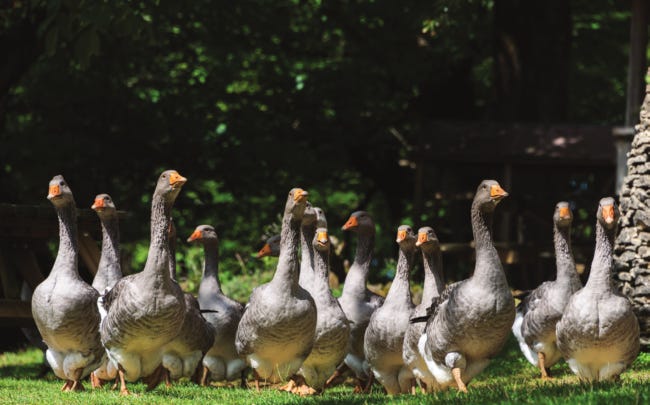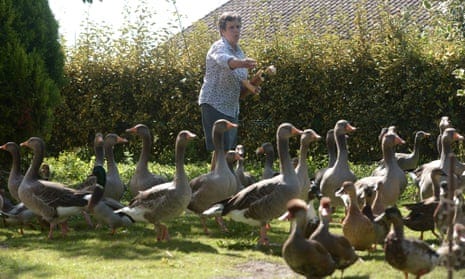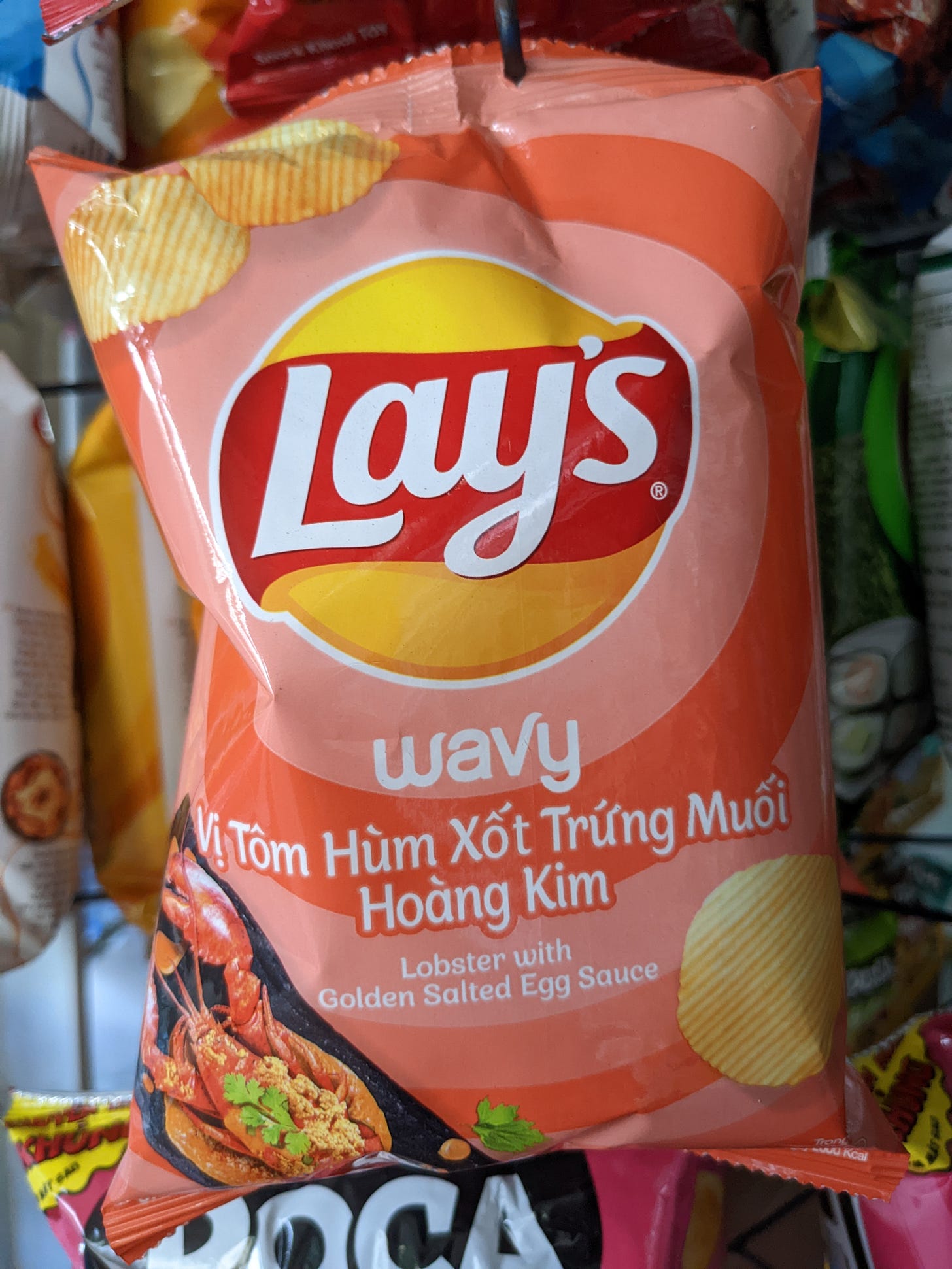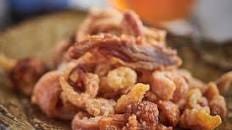Ducks have a long history of challenge and adversity. The farmer wouldn’t allow Beatrix Potter’s Jemima Puddle-Duck to keep the eggs she laid, so she found a nesting place in the forest. A charming gentleman fox talks her into nesting comfortably at his house on a mysteriously ample supply of feathers. Naive Jemima is sent out to collect the herbs traditional for stuffing a duck, the fox explaining they were for an omelette. Kep, the farm collie, sees through the evil fox's plan, rescues Jemima and escorts her back to the farm where she’s finally allowed to hatch her ducklings.
Children’s books can be more terrifying than adults’.
There was a time, inviting a regular summer stream of guests to stay in the Dordogne in Southwest France, when I wrote a Duck Diary blog. I pinched the idea from Bridget Jones, who began every diary entry of her own with a daily list of the number of cigarettes she had smoked and the number of calories she had consumed. My diary noted the quantity of ducks and their various parts I had cooked and eaten, and in how many different ways. Famous for its ducks and geese, every visitor to the Périgord, the name by which its locals know the Dordogne, wanted to eat the regional speciality in every manner it was offered. (With some exceptions. Gizzards were reduced in fandom once they discovered what a gizzard was even if they did form the foundation of a delicious salad.) By the time summer was over, I flew home with webbed feet.
The French treat the duck much as the Chinese treat pigs: not a single part of the creature goes to waste. Legs are confitted, as are gizzards and hearts, the breasts (magrets) are treated like steaks and grilled, aiguillettes (under-fillets) are quickly sautéed in a mustard, vinegar and honey sauce. Other parts of the flesh appear in country pâtés, and the livers are turned into glorious foie gras.
(Before you reach for your outrage, artisan- not mass-produced foie gras comes from geese that waddle at speed across the field to meet the farmer bearing pail of corn and funnel. Neither geese nor ducks have gag reflexes. Also, they voluntarily stuff themselves and therefore their livers as larders for their long migration flights. Worry instead about the inhumane plight of the billions of industrially-raised chickens we eat before concerning yourselves over a global foie gras market of 21,640 tonnes.)
The trouble in cooking duck was, there was a part of the bird that despite every effort could go to waste. Not the bones, which made a rich broth, and not the feet nor the tongues, which I am prepared to eat in China but not in France. It was the skin. A surprisingly large number of diners wouldn’t eat it. So I would turn it into ‘scratchings’ - crunchy, crispy nodules to eat with evening aperitifs that no one turned down.
Snacks designed to be eaten with drinks fall into a different category from the snacks we have no reason to eat at all apart from greed. Popcorn Kitchen, a British company describing itself as one of the original gourmet popcorn pioneers, has just announced with pride their launch of Blueberry Muffin Popcorn to add to their range that includes Cherry Bakewell and White-Chocolate-and-Raspberry flavours. What can one say…At least it isn’t Joe & Seph’s Gin & Tonic Popcorn which surely ruins both elements. Popcorn, artisanal or otherwise, is trying to make inroads into the British snacks market, a market rigidly crisps focused.
The Brits, population 67.33 million*, munch through 20 million packs of crisps a day. In 2020, 3.69 million Americans each ate 16 or more sacks of potato chips in 30 days. 284.37 million bags were consumed in the USA in that year. The size of the bags isn’t specified but the American word for a container of chips is not ‘bag’ but ‘sack’. The basic bag in the UK contains 34.5 grams of chips. In the US, the basic bag contains 42.5 grams.
South East Asia is a hearty cruncher of crisps. Their weird and wonderful range of flavours far exceeds the UK’s penchant for crisps which in their most exotic versions can taste like prawn cocktail or a Sunday roast. From Singapore to Saigon and points east, you can snack on simple cucumber flavoured crisps to numb-and-spicy hot pot, garlic soft shell crab, chocolate swirl, and hot-and-sour fish soup ones. It’s a market worth $7.1 billion in 2022.
This may not continue to be an option. There is a terrible shortage of potatoes in Japan, huge manufacturers of crisps under the Calbee brand, a portmanteau name for calcium and vitamin B1. Because of recent extreme hot weather and low rainfall in Hokkaido where most of the potatoes are grown, there is a large decrease in the potato harvest which will raise the price of potatoes by up to 10 percent.
The upside of any reduction in crisp buying is it will reduce production of the packages they are sold in. Once upon a time, these were humble paper packets. Nowadays, crisps come inside garishly printed silvery linings you can’t crumple and which help extend their shelf life but which are un-recyclable and remain intact for 33 years. 33 years from now, there will be approximately 200 billion more crisp packets in British landfills alone.
If you have the skin of a duck hanging about - or the skin of a chicken or other fowl, don’t chuck it. Pour yourself an aperitif and make these scratchings to eat with it.
Skin of 2 duck breast or legs
200ml/6¾ fl oz duck fat or vegetable oil
Run a finger under the skin of the bird and lift it away then with a sharp knife slice it in half lengthways and then across. Cut the pieces again into 1cm slices and pat dry with kitchen paper.
Heat the oil or duck fat in a small and deep pan on a medium heat to super hot - just around smoking point. Sprinkle in a number of skin pieces and watch them puff up and turn gold and crispy, 2 to 3 minutes, turning once or twice. Drain them out with a slotted spoon and spread onto kitchen towel to drain. Sprinkle over some salt to taste and cool before eating.
If you'd prefer a more substantial duck recipe, try this one for Peking duck.
*2021 census











I have cans of confit duck gizzards from the Perigord in my cupboard for emergency, indulgent lunch salads! Also thank you for your common sense words on one of my favourite food stuffs!
Duck in all its variety is a dish for princes (though I believe our King has eschewed foie gras ...). Personally, I love it, and a bird which can be used in its entirety (except for the quack!) makes great ecological sense. I've never quite understood why so many won't eat skin, it's so tasty! I've never tried to make Peking duck, but I think I shall have to give it a try